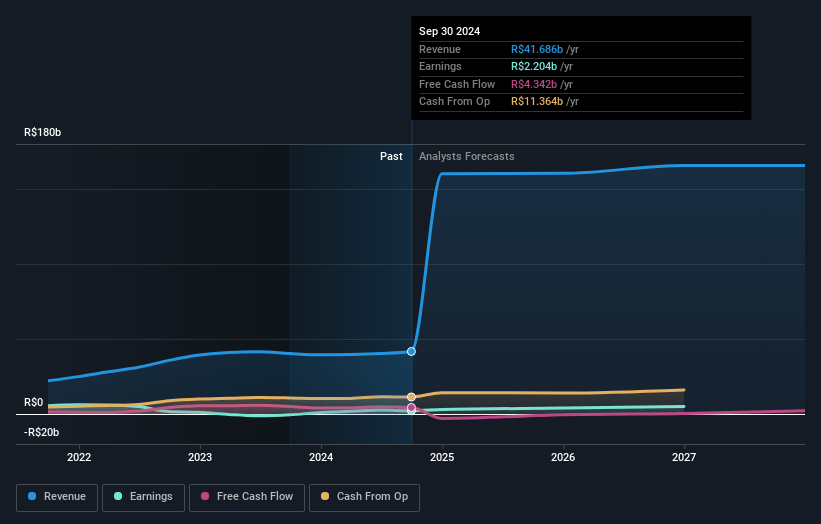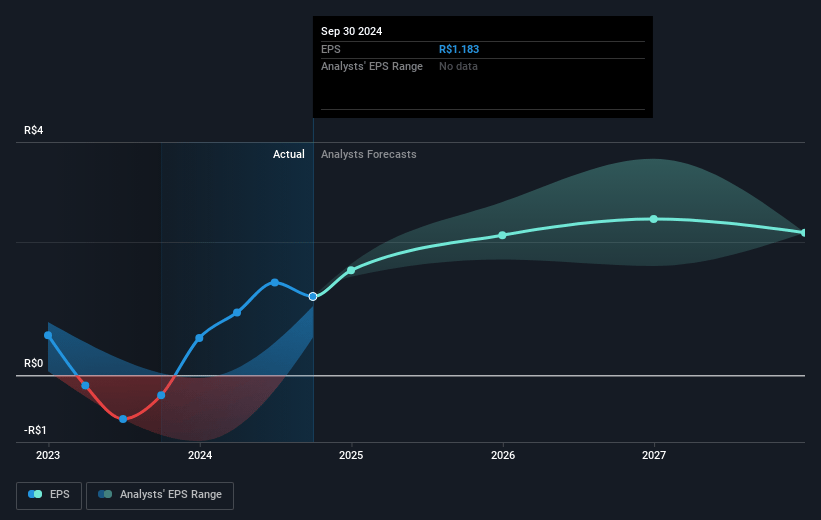Key Takeaways
- Active debt management and strategic divestments could enhance financial stability and improve net margins.
- Growth in transport, natural gas, and strategic partnerships may drive future revenue and earnings resilience.
- Rising financial costs, adverse currency effects, and operational challenges may pressure Cosan's earnings, prompting divestments to manage debt and stabilize finances.
Catalysts
About Cosan- Engages in the fuel distribution business.
- Cosan's management is focusing on active debt management and capital structure optimization by using the proceeds from the Vale stake divestment to reduce and manage debt levels, which could lead to lower financial expenses and improved net margins.
- The growth in transported volumes and tariffs at Rumo and the expansion of the natural gas business at Compass (including new operations like the regas terminal) are expected to drive future revenue growth for these segments of the portfolio.
- Strategic portfolio recycling, including divestments and acquisitions, allows Cosan to navigate challenging macro conditions while maintaining or enhancing asset quality, potentially improving overall earnings resilience.
- Cosan's focus on operational efficiency and capital discipline at Moove, despite challenges like lower volumes and the impact of the fire, indicates potential for better margins and earnings stability.
- Implementation of strategic partnerships and more creative funding options for subsidiaries like Raizen could facilitate growth while alleviating the financial burden on the holding company, potentially supporting future net income growth.
Cosan Future Earnings and Revenue Growth
Assumptions
How have these above catalysts been quantified?- Analysts are assuming Cosan's revenue will grow by 59.8% annually over the next 3 years.
- Analysts assume that profit margins will increase from -22.1% today to 3.1% in 3 years time.
- Analysts expect earnings to reach R$5.5 billion (and earnings per share of R$2.97) by about May 2028, up from R$-9.7 billion today. However, there is a considerable amount of disagreement amongst the analysts with the most bullish expecting R$7.5 billion in earnings, and the most bearish expecting R$3.9 billion.
- In order for the above numbers to justify the analysts price target, the company would need to trade at a PE ratio of 10.5x on those 2028 earnings, up from -1.5x today. This future PE is greater than the current PE for the BR Oil and Gas industry at 8.5x.
- Analysts expect the number of shares outstanding to decline by 0.06% per year for the next 3 years.
- To value all of this in today's terms, we will use a discount rate of 26.12%, as per the Simply Wall St company report.
Cosan Future Earnings Per Share Growth
Risks
What could happen that would invalidate this narrative?- The deterioration in inflation expectations and Brazil's debt trajectory, resulting in a new interest rate hike cycle, may increase financial costs, impacting net margins and future earnings.
- The depreciation of the Brazilian Real negatively affecting the value of perpetual bonds and shares, which could lead to further financial losses and impact net earnings.
- Significant challenges in sugarcane crushing due to dry weather and fires, impacting Raizen's results, could pressure revenues and EBITDA if adverse conditions persist.
- Negative results excluding nonrecurring items, such as the negative R$900 million result due to financial impacts, suggest a vulnerability in earnings stability.
- Need to reduce corporate net debt of R$23.4 billion and improve leverage ratios may require divestments, potentially impacting future revenue and strategic growth opportunities.
Valuation
How have all the factors above been brought together to estimate a fair value?- The analysts have a consensus price target of R$15.542 for Cosan based on their expectations of its future earnings growth, profit margins and other risk factors. However, there is a degree of disagreement amongst analysts, with the most bullish reporting a price target of R$29.0, and the most bearish reporting a price target of just R$9.0.
- In order for you to agree with the analyst's consensus, you'd need to believe that by 2028, revenues will be R$179.3 billion, earnings will come to R$5.5 billion, and it would be trading on a PE ratio of 10.5x, assuming you use a discount rate of 26.1%.
- Given the current share price of R$7.73, the analyst price target of R$15.54 is 50.3% higher.
- We always encourage you to reach your own conclusions though. So sense check these analyst numbers against your own assumptions and expectations based on your understanding of the business and what you believe is probable.
How well do narratives help inform your perspective?
Disclaimer
Warren A.I. is a tool utilizing a Large Language Model (LLM) that ingests data on consensus price targets, forecasted revenue and earnings figures, as well as the transcripts of earnings calls to produce qualitative analysis. The narratives produced by Warren A.I. are general in nature and are based solely on analyst data and publicly-available material published by the respective companies. These scenarios are not indicative of the company's future performance and are exploratory in nature. Simply Wall St has no position in the company(s) mentioned. Simply Wall St may provide the securities issuer or related entities with website advertising services for a fee, on an arm's length basis. These relationships have no impact on the way we conduct our business, the content we host, or how our content is served to users. The price targets and estimates used are consensus data, and do not constitute a recommendation to buy or sell any stock, and they do not take account of your objectives, or your financial situation. Note that Warren A.I.'s analysis may not factor in the latest price-sensitive company announcements or qualitative material.




